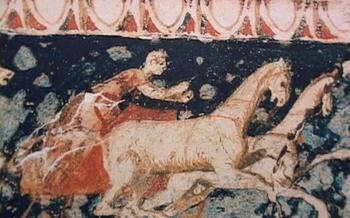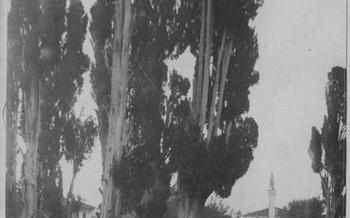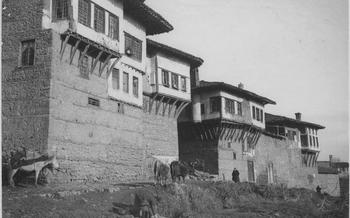
Macedonian Tombs of Korinos
- The Macedonian Tombs of Korinos: A Historical and Cultural Treasure
- Discover the Fascinating History Behind the Tombs
- Explore the Intriguing Architecture of the Tombs
- Immerse Yourself in the Rich Symbolism of the Tombs
- Witness the Remarkable Frescoes Adorning the Tombs
- Admire the Impressive Artifacts Unearthed from the Tombs
- Uncover the Secrets of the Royal Tomb of Vergina
- Learn about the Archaeological Museum of Vergina
- Explore the Ancient City of Dion
- Discover the Natural Beauty of Katerini
- Explore Other Historical Sites in the Region
- Insider Tip: Uncover Hidden Gems Off the Beaten Path
The Macedonian Tombs of Korinos: A Historical and Cultural Treasure
In the heart of Greece's Pieria region, nestled amidst rolling hills and lush greenery, lies a remarkable collection of ancient tombs that offer a glimpse into the rich history and cultural heritage of the Macedonian civilization. These are the Macedonian Tombs of Korinos, a series of subterranean burial chambers that date back to the 4th century BC, during the reign of the powerful Kingdom of Macedonia.
The tombs, discovered in the late 19th century, have captivated historians, archaeologists, and visitors alike with their impressive architecture, intricate symbolism, and the wealth of artifacts they contain. Each tomb is meticulously constructed, showcasing unique architectural features and artistic motifs that reflect the sophisticated craftsmanship and cultural significance of the Macedonian era.
These tombs were not merely burial chambers but elaborate monuments dedicated to honoring the deceased and preserving their legacy. They provide valuable insights into the beliefs, customs, and artistic traditions of the ancient Macedonians, offering a tangible connection to the past.
The Macedonian Tombs of Korinos are conveniently located near the modern city of Katerini, making them easily accessible for visitors who wish to delve into the depths of Macedonian history and culture. A visit to these ancient tombs is a journey through time, allowing visitors to unravel the mysteries of a bygone era and witness the enduring legacy of one of antiquity's most remarkable civilizations.
Discover the Fascinating History Behind the Tombs
The Macedonian Tombs of Korinos stand as testaments to the rich history and cultural heritage of the ancient Kingdom of Macedonia. Founded by King Perdiccas I in the 7th century BC, the kingdom rose to prominence under the reign of Philip II, who transformed Macedonia into a powerful military force. His son, Alexander the Great, inherited the throne and embarked on a remarkable journey of conquest, expanding the Macedonian Empire to unprecedented heights. The tombs of Korinos, built during this era of Macedonian dominance, offer a glimpse into the grandeur and opulence of the kingdom.
These tombs were constructed as elaborate resting places for Macedonian royalty and high-ranking officials. Each tomb is unique in its design and decoration, reflecting the wealth and status of its occupant. The tombs are adorned with intricate frescoes depicting scenes from mythology, hunting, and daily life, providing valuable insights into Macedonian culture and beliefs.
The discovery of the tombs in the early 20th century shed new light on the history of Macedonia. Archaeological excavations revealed a wealth of artifacts, including gold jewelry, pottery, weapons, and other precious objects, which helped historians piece together the story of this ancient civilization. The tombs of Korinos serve as a tangible reminder of the power and influence of the Macedonian Kingdom, and their significance extends far beyond their role as burial chambers.
Explore the Intriguing Architecture of the Tombs
The Macedonian Tombs of Korinos stand out for their distinctive architectural style, showcasing the advanced construction techniques and artistic prowess of the ancient Macedonians. Each tomb exhibits unique features that set it apart.
The tombs are constructed using large stone blocks, carefully fitted together without the use of mortar. This impressive feat of engineering ensures the structural integrity of the tombs, allowing them to withstand the test of time.
One of the most remarkable aspects of the tombs is their intricate and diverse ornamentation. The facades are adorned with elaborate carvings, depicting various scenes and motifs. These carvings often incorporate symbolic elements, such as animals, plants, and mythological figures, which hold deep cultural and religious significance.
The interiors of the tombs are equally captivating, featuring vaulted ceilings and intricate wall paintings. These murals showcase the artistic talents of the Macedonian craftsmen and provide valuable insights into the beliefs and customs of the ancient Macedonian civilization.
Overall, the architectural design of the Macedonian Tombs of Korinos reflects the ingenuity, skill, and artistry of the ancient Macedonians, creating a lasting legacy that continues to captivate visitors to this day.
Immerse Yourself in the Rich Symbolism of the Tombs
The Macedonian tombs of Korinos are adorned with a wealth of intricate symbols, each holding profound meaning and significance. These symbols, often depicted in the form of animals, plants, and mythological figures, offer a glimpse into the beliefs and values of the ancient Macedonians.
Animals were frequently used to symbolize strength, courage, and power. The lion, for instance, was associated with the Macedonian monarchy, representing the fierce and majestic nature of the ruling dynasty.
Plants also played a significant role in Macedonian symbolism. The lotus flower, with its ability to rise from murky waters, symbolized rebirth and eternal life. The ivy, with its clinging nature, represented loyalty and devotion.
Mythological figures were another common motif in the tombs. Hercules, the demigod known for his strength and courage, was often depicted as a symbol of protection and divine favor.
Beyond their individual meanings, these symbols collectively formed a complex narrative that reflected the beliefs and aspirations of the ancient Macedonians. They communicated messages about the afterlife, the divine realm, and the importance of honor, loyalty, and courage.
By deciphering the symbolism found in the tombs, we gain a deeper understanding of the rich cultural and spiritual heritage of the ancient Macedonian civilization.
Witness the Remarkable Frescoes Adorning the Tombs
The Macedonian Tombs of Korinos are not only architectural marvels but also treasure troves of stunning frescoes that captivate visitors with their intricate designs and symbolic significance. These frescoes, created using various techniques, depict a range of scenes, including hunting expeditions, mythological narratives, and everyday life in ancient Macedonia.
The thematic elements found in these frescoes provide valuable insights into the beliefs, customs, and traditions of the Macedonian people. Animals, plants, and mythological figures are commonly depicted, each carrying specific symbolic meanings. For instance, the lion represents strength and courage, while the eagle symbolizes power and authority.
The connection between the frescoes and ancient Greek mythology is particularly intriguing. Many of the scenes depicted in the tombs draw inspiration from Greek myths, showcasing the deep cultural and religious ties between the Macedonians and the wider Hellenic world.
Conservation efforts have been undertaken to preserve these exquisite frescoes, ensuring that future generations can continue to appreciate their beauty and historical significance. Visitors can marvel at the vibrant colors and intricate details of these ancient masterpieces, gaining a deeper understanding of Macedonian culture and its enduring legacy.
Admire the Impressive Artifacts Unearthed from the Tombs
Enrich your understanding of Macedonian culture and history by exploring the remarkable artifacts discovered within the Macedonian Tombs of Korinos. These tombs have yielded a treasure trove of precious artifacts, each offering valuable insights into the daily lives, customs, and beliefs of the ancient Macedonians.
Unearthed from the burial chambers, archaeologists have uncovered a diverse array of objects, including finely crafted pottery, exquisite jewelry, and intricately designed weapons. These artifacts provide tangible evidence of the Macedonians' artistic prowess, technical skills, and military might.
Among the pottery collection, you'll find an array of vessels, from simple utilitarian pieces to elaborately decorated vases and amphorae. These vessels often feature intricate patterns, figural motifs, and scenes from mythology, showcasing the Macedonians' mastery of ceramic arts.
Jewelry discovered in the tombs reveals the Macedonians' love of adornment and their skilled craftsmanship. Gold, silver, and bronze ornaments, including necklaces, earrings, bracelets, and rings, showcase intricate filigree work, delicate granulation, and the use of precious gemstones.
Weapons, such as swords, spears, and helmets, unearthed from the tombs shed light on the military prowess of the Macedonians. These finely crafted weapons, often adorned with intricate designs and symbols, speak to the importance of warfare in Macedonian society.
These artifacts, now housed in museums and archaeological collections, offer a tangible connection to the past, providing valuable insights into the life and culture of the ancient Macedonians. Their historical significance and exquisite craftsmanship make them must-see treasures for anyone interested in ancient history and archaeology.
Uncover the Secrets of the Royal Tomb of Vergina
Situated just outside the town of Vergina, the Royal Tomb of Vergina stands as a remarkable testament to the grandeur and opulence of the ancient Macedonian kingdom. Unearthed in 1977 by renowned Greek archaeologist Manolis Andronikos, this extraordinary tomb captivated the world with its stunning artifacts and its connection to Alexander the Great.
Within the confines of the tomb, Andronikos discovered a wealth of treasures, including intricate gold jewelry, finely crafted weapons, and the iconic golden larnax, an ornate casket believed to have held the cremated remains of Philip II, Alexander's father. The larnax, adorned with intricate scenes from Greek mythology, remains one of the most significant archaeological discoveries in Greek history.
The Royal Tomb of Vergina is not only a treasure trove of artifacts but also a testament to the remarkable craftsmanship and artistry of the ancient Macedonians. The tomb's well-preserved frescoes depict scenes from Macedonian history and mythology, offering a glimpse into the beliefs and values of this ancient civilization.
Currently, the tomb is open to the public, allowing visitors to experience the grandeur of this remarkable site firsthand. As you stand within the confines of the tomb, surrounded by the echoes of history, you can't help but be awestruck by the majesty of the Macedonian civilization and its enduring legacy.
Learn about the Archaeological Museum of Vergina
Housed within the modern town of Vergina, the Archaeological Museum stands as a testament to the rich history and cultural heritage of the ancient Macedonian Kingdom. This state-of-the-art facility serves as the primary repository for the priceless artifacts unearthed from the royal tombs, including the world-renowned golden larnax of Philip II.
Through a captivating display of intricate gold jewelry, exquisite pottery, and finely crafted weapons, the museum narrates the compelling tale of Macedonian civilization. Interactive exhibits and multimedia presentations bring to life the opulence, artistry, and military prowess of this once-mighty kingdom.
For those seeking a deeper understanding of the Macedonian era, the museum offers guided tours led by knowledgeable experts who provide insightful commentary and historical context. Educational programs and workshops are also organized to engage visitors of all ages, fostering a sense of appreciation for the region's cultural legacy.
Planning your visit to the Archaeological Museum of Vergina is essential to maximize your experience. Check the museum's website for opening hours, admission fees, and any special events or exhibitions that may be taking place during your visit. Guided tours are highly recommended to gain a comprehensive understanding of the artifacts and their significance.
Combine your visit to the museum with a tour of the ancient city of Vergina, located just a short distance away. This immersive experience will allow you to delve deeper into the fascinating world of the Macedonians and their enduring legacy.
Explore the Ancient City of Dion
Dion, located just 15 kilometers southwest of Katerini, offers a glimpse into the rich history of ancient Macedonia. This ancient city, founded in the 5th century BC, served as a religious and political center for the Macedonians and was closely associated with the royal family. Dion's strategic location at the foot of Mount Olympus, the mythical home of the Greek gods, contributed to its significance.
Must-see archaeological sites:
-
Temple of Zeus: Dedicated to the supreme god Zeus, this well-preserved temple stands as a testament to ancient Greek architecture.
-
Theater: Built in the 4th century BC, the theater hosted theatrical performances and other cultural events.
Connection to the Macedonian Royal Family:
-
Sanctuary of Isis: This sanctuary, dedicated to the Egyptian goddess Isis, was frequented by members of the Macedonian royal family, seeking guidance and protection.
-
Royal Tombs: Several royal tombs have been discovered in Dion, providing insights into the lives of Macedonian royalty.
Tips for Visiting Dion:
-
Combine with Macedonian Tombs: Dion is conveniently located near the Macedonian Tombs of Korinos, allowing you to combine both sites in one trip.
-
Guided Tours: Consider booking a guided tour to learn more about the history and significance of Dion's archaeological sites.
-
Plan Your Visit: Allow ample time to explore Dion's ruins, as the site is quite extensive.
Discover the Natural Beauty of Katerini
Beyond its historical treasures, Katerini boasts a stunning natural landscape that captivates visitors with its scenic beauty. Along the coastline, pristine beaches and crystal-clear waters beckon sunseekers to relax and soak up the Mediterranean sun. Whether you prefer lounging on the golden sands or taking a refreshing dip in the azure sea, Katerini's beaches offer a tranquil haven for those seeking a peaceful retreat.
For those who prefer a more active experience, Katerini's surroundings offer a wealth of opportunities for outdoor enthusiasts. Picturesque hiking trails wind through lush forests and lead to breathtaking viewpoints that offer panoramic vistas of the region. The verdant landscapes provide a sanctuary for nature lovers, who can spot a diverse array of flora and fauna, including rare birds and wildflowers.
Adrenaline seekers can indulge in various water sports and outdoor activities that Katerini has to offer. From windsurfing and kitesurfing to kayaking and jet skiing, the crystal-clear waters provide a playground for those seeking adventure. Mountain biking enthusiasts can explore the challenging trails that traverse the region's hills and valleys, offering a thrilling ride amidst stunning natural scenery.
To fully immerse yourself in the natural wonders of Katerini, consider venturing off the beaten path and discovering hidden gems that await exploration. Secluded coves with crystal-clear waters invite you to bask in the tranquility of nature, while lush forests offer a refreshing escape from the summer heat. Embrace the opportunity to connect with the region's breathtaking landscapes and create lasting memories in this enchanting natural paradise.
Explore Other Historical Sites in the Region
In addition to the Macedonian Tombs of Korinos, the region surrounding Katerini boasts a wealth of other historical sites and attractions. History enthusiasts will delight in exploring the ancient ruins and landmarks that dot the landscape, offering a glimpse into the rich tapestry of the region's past.
The nearby archaeological site of Dion, once a flourishing city-state and a religious center of ancient Macedonia, is a must-visit for history buffs. Here, visitors can marvel at the well-preserved remains of temples, theaters, and other impressive structures, providing a glimpse into the grandeur of this ancient city.
Other notable historical sites in the region include the medieval fortress of Platamonas, perched dramatically on a rocky outcrop overlooking the Aegean Sea, and the picturesque village of Palaios Panteleimonas, with its charming cobbled streets and traditional Macedonian architecture.
To fully immerse yourself in the region's history, consider embarking on a themed route or itinerary that connects various historical sites. This could include following the footsteps of Alexander the Great, exploring the Byzantine heritage of the region, or tracing the ancient trade routes that once crisscrossed Macedonia.
Whether you choose to follow a guided tour or venture out on your own, exploring the historical sites in the region surrounding Katerini is a rewarding experience that will deepen your understanding of this fascinating corner of Greece.
Insider Tip: Uncover Hidden Gems Off the Beaten Path
While the Macedonian Tombs of Korinos and the other popular attractions in Katerini offer a wealth of history and culture, there are also hidden gems waiting to be discovered off the beaten path. Venture beyond the main tourist areas to uncover lesser-known historical sites, unique experiences, and breathtaking natural landscapes. Explore ancient ruins nestled amidst tranquil countryside, visit charming traditional villages, or embark on scenic hiking trails leading to secluded beaches and panoramic views. Ask locals for recommendations, seek out local festivals and events, and embrace the opportunity to immerse yourself in the authentic culture of Katerini. With a little curiosity and exploration, you'll discover the true essence of this captivating region.
Here are some insider tips for uncovering hidden gems in Katerini:
-
Visit the Folklore Museum of Katerini to learn about the region's rich cultural heritage and traditions.
-
Explore the picturesque village of Platamonas, known for its medieval castle and stunning views of the Aegean Sea.
-
Indulge in a traditional Greek feast at a local taverna in one of the charming mountain villages.
-
Hike to the summit of Mount Olympus, the highest mountain in Greece, for breathtaking panoramic views.
-
Discover the secluded beaches of Paralia Skotinas, a hidden paradise with crystal-clear waters and golden sands.
Remember to respect the local culture and environment, and always ask permission before entering private property or sacred sites. Embrace the spirit of adventure and prepare to be amazed by the hidden treasures that await in Katerini.




